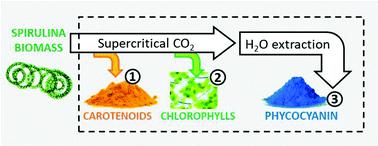当前位置:
X-MOL 学术
›
Green Chem.
›
论文详情
Our official English website, www.x-mol.net, welcomes your feedback! (Note: you will need to create a separate account there.)
Carotenoids, chlorophylls and phycocyanin from Spirulina: supercritical CO2 and water extraction methods for added value products cascade
Green Chemistry ( IF 9.8 ) Pub Date : 2019-11-21 , DOI: 10.1039/c9gc03292d Stefania Marzorati 1, 2, 3, 4 , Andrea Schievano 1, 2, 3, 4 , Antonio Idà 3, 4, 5 , Luisella Verotta 1, 2, 3, 4
Green Chemistry ( IF 9.8 ) Pub Date : 2019-11-21 , DOI: 10.1039/c9gc03292d Stefania Marzorati 1, 2, 3, 4 , Andrea Schievano 1, 2, 3, 4 , Antonio Idà 3, 4, 5 , Luisella Verotta 1, 2, 3, 4
Affiliation

|
In the last decade, the cyanobacterium Spirulina has gained a high commercial interest as a food supplement, mainly due to its high protein content as well as high amounts of pigments, such as carotenoids, chlorophylls and phycocyanins. In particular, phycocyanin has been widely considered as a precious food-dye because of its protein-based structure and the rare intense-blue color. Different strategies were developed for the isolation and purification of phycocyanin. The main drawback of such processes is that carotenoids and chlorophylls are generally wasted together with the residual biomass. In this study, a different approach is proposed, suggesting an integrated pigment extraction chain. The body of the strategy involves two consecutive steps of the supercritical-CO2 extraction of carotenoids and chlorophylls, before phycocianin extraction. The total carotenoid, chlorophyll a and chlorophyll b contents in the extracts were equal to 3.5 ± 0.2 mg g−1, 5.7 ± 0.2 mg g−1 and 3.4 ± 0.3 mg g−1, respectively (by dry Spirulina weight). The biomass residue, exhausted in terms of carotenoids and chlorophylls, was then extracted in water to yield phycocyanin. Consecutive steps were developed in order to ehance the phycocyanin purity, including electrocoagulation, dialysis and protein salting-out. These processes yielded 250 mg g−1 of phycocyanin (by dry Spirulina weight). A potentially scalable strategy to obtain the blue pigment with high purity (A620/A280 = 2.2) was developed. The practical application of the extracted blue phycocyanin pigment as a cotton-based tissue colorant was also experimented.
中文翻译:

螺旋藻中的类胡萝卜素,叶绿素和藻蓝蛋白:附加值产品的超临界二氧化碳和水提取方法
在过去的十年中,蓝藻螺旋藻作为食品补充剂获得了很高的商业兴趣,这主要是由于其高蛋白含量以及大量色素,例如类胡萝卜素,叶绿素和藻蓝蛋白。特别是,藻蓝蛋白由于其基于蛋白质的结构和稀有的深蓝色而被广泛认为是一种珍贵的食用染料。为分离和纯化藻蓝蛋白开发了不同的策略。这种方法的主要缺点是类胡萝卜素和叶绿素通常会与残留的生物质一起浪费掉。在这项研究中,提出了一种不同的方法,表明了整合的颜料提取链。该策略的主体涉及超临界CO 2的两个连续步骤提取藻红蛋白之前先提取类胡萝卜素和叶绿素。在提取物中的总类胡萝卜素,叶绿素a和叶绿素b含量等于3.5±0.2毫克克-1,5.7±0.2毫克克-1和3.4±0.3毫克克-1分别(以干螺旋藻重量计)。然后将水中的类胡萝卜素和叶绿素消耗掉的生物质残留物在水中提取,得到藻蓝蛋白。为了提高藻蓝蛋白的纯度,开发了连续步骤,包括电凝,透析和蛋白质盐析。这些过程产生250mg g -1的藻蓝蛋白(按干螺旋藻重量计)。一种获得高纯度蓝色颜料的潜在可扩展策略(A 620 / A280 = 2.2)。还对提取的蓝色藻蓝蛋白色素作为棉基组织着色剂的实际应用进行了实验。
更新日期:2019-11-21
中文翻译:

螺旋藻中的类胡萝卜素,叶绿素和藻蓝蛋白:附加值产品的超临界二氧化碳和水提取方法
在过去的十年中,蓝藻螺旋藻作为食品补充剂获得了很高的商业兴趣,这主要是由于其高蛋白含量以及大量色素,例如类胡萝卜素,叶绿素和藻蓝蛋白。特别是,藻蓝蛋白由于其基于蛋白质的结构和稀有的深蓝色而被广泛认为是一种珍贵的食用染料。为分离和纯化藻蓝蛋白开发了不同的策略。这种方法的主要缺点是类胡萝卜素和叶绿素通常会与残留的生物质一起浪费掉。在这项研究中,提出了一种不同的方法,表明了整合的颜料提取链。该策略的主体涉及超临界CO 2的两个连续步骤提取藻红蛋白之前先提取类胡萝卜素和叶绿素。在提取物中的总类胡萝卜素,叶绿素a和叶绿素b含量等于3.5±0.2毫克克-1,5.7±0.2毫克克-1和3.4±0.3毫克克-1分别(以干螺旋藻重量计)。然后将水中的类胡萝卜素和叶绿素消耗掉的生物质残留物在水中提取,得到藻蓝蛋白。为了提高藻蓝蛋白的纯度,开发了连续步骤,包括电凝,透析和蛋白质盐析。这些过程产生250mg g -1的藻蓝蛋白(按干螺旋藻重量计)。一种获得高纯度蓝色颜料的潜在可扩展策略(A 620 / A280 = 2.2)。还对提取的蓝色藻蓝蛋白色素作为棉基组织着色剂的实际应用进行了实验。



























 京公网安备 11010802027423号
京公网安备 11010802027423号